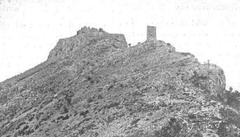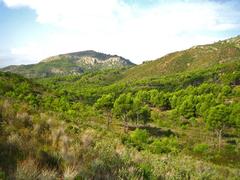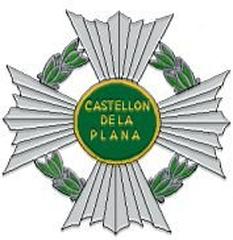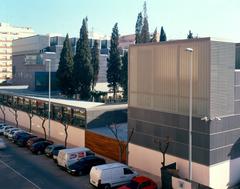Castellón De La Plana Railway Station: Visiting Hours, Tickets, and Travel Guide
Date: 15/06/2025
Introduction
Castellón De La Plana Railway Station (Estación de Castellón de la Plana) stands as a vital gateway in the heart of Castelló de la Plana, Spain. Since its establishment in 1862 as part of the Valencia-Tarragona line, the station has been crucial to the region’s economic growth, urban development, and connectivity, evolving from a modest 19th-century building to a contemporary hub integrated into Spain’s Mediterranean Corridor. Today, it seamlessly combines historical legacy with modern amenities, serving local commuters, business travelers, and tourists alike.
This comprehensive guide details everything you need to know about the station: visiting hours, ticket booking, accessibility, travel tips, nearby attractions, and insights into its historical and cultural significance. Whether you are arriving for a short trip or an extended stay, this resource will help ensure your time at Castellón De La Plana Railway Station is efficient and enjoyable.
For official updates, visit the Renfe website and the Castellón tourism portal.
Table of Contents
- Historical Evolution of Castellón De La Plana Railway Station
- Practical Visitor Information
- Modernization and Recent Upgrades
- Strategic Location and Urban Connectivity
- Station Facilities and Passenger Services
- Transport Connections
- Nearby Historical Sites and Attractions
- Concatedral de Santa Maria: Visiting Guide
- Practical Travel Tips
- Frequently Asked Questions (FAQ)
- Summary and Final Tips
- References and Further Reading
Historical Evolution of Castellón De La Plana Railway Station
Origins and Early Development
Opened in 1862, Castellón De La Plana Railway Station was integral to transporting regional products such as ceramics and oranges, fueling Castellón’s economic rise. The original station, located north of the city center near Ribalta Park, was practical in design and served as a focal point for rail expansion (Wikipedia).
Architectural Significance and Urban Impact
The station’s architecture evolved over time, reflecting Castellón’s growth. Early expansions introduced modernist touches and improved facilities, embedding the station in the city’s social and cultural life. Its proximity to landmarks like Parque Ribalta and Casa de las Cigüeñas made it a vital urban feature.
Role in Regional and National Rail Networks
As a key node in the Mediterranean Corridor, the station connects Spain’s southern and eastern coasts with Catalonia and France. It accommodates Cercanías commuter trains, regional services, and high-speed AVE trains, supporting both local mobility and national travel. During the Spanish Civil War and subsequent industrial resurgence, the station played a strategic role in Castellón’s development.
Practical Visitor Information
Visiting Hours
The station operates daily, typically from 5:00 AM to 11:30 PM, aligning with train schedules. Services such as ticket offices and automated machines are available throughout these hours. For variations during holidays, confirm with Renfe or Castellón Turismo.
Tickets and Booking
Purchase tickets at staffed counters, automated machines, or online via the Renfe website. Options include single, return, and regional passes, with discounts for seniors, students, and groups. For high-speed AVE, advance booking is recommended for better availability and prices (The Trainline).
Accessibility
The station is fully accessible, offering ramps, elevators, tactile paving, accessible restrooms, and staff assistance. Multilingual signage and announcements are in Spanish and Valencian (Facts.net).
Tourist Information
A Tourist Info office at Calle Pintor Oliet, 2, provides maps, event guides, and multilingual support (Castellón Turismo).
Modernization and Recent Upgrades
21st Century Transformation
Extensive modernization has equipped the station for high-speed AVE and Euromed trains, reducing travel times to Valencia (about 40 minutes) and Madrid (approx. 2.5 hours). Upgrades include advanced security, digital information boards, and enhanced amenities.
Sustainability and Urban Renewal
The station incorporates energy-efficient lighting, water conservation, waste management, and encourages sustainable transport via integration with TRAM, buses, and cycling infrastructure (UNaLab).
Strategic Location and Urban Connectivity
Situated on Carrer del Pintor Oliet, just west of the city center, the station is ideally placed for accessing hotels, restaurants, and administrative centers (Spain.info). The urban bus network (12 lines), TRAM de Castellón, and nearby taxi ranks ensure seamless citywide connections. Pedestrian-friendly zones and cycling paths further promote sustainable exploration.
Station Facilities and Passenger Services
Ticketing and Information
Staffed ticket offices, automated machines, and an information desk assist with bookings and travel queries.
Waiting Areas
Spacious, climate-controlled waiting rooms with real-time train updates cater to all travelers.
Food, Beverage, and Retail
Cafés, vending machines, kiosks, and newsstands provide refreshments and travel essentials.
Luggage and Storage
Lockers and left-luggage facilities are available during station hours.
Wi-Fi and Charging
Free Wi-Fi and charging stations are provided throughout the station.
Restrooms and Hygiene
Clean, accessible restrooms are maintained, with hygiene standards regularly monitored.
Security
CCTV surveillance and on-site security personnel ensure a safe environment.
Transport Connections
Train Services
- Euromed: High-speed trains connecting Castellón to Barcelona, Alicante, and other Mediterranean cities.
- Alvia: Long-distance trains to Madrid and beyond.
- Cercanías: Frequent regional services to Valencia and neighboring towns (Wikipedia).
Local and Regional Buses
City buses and intercity buses operate from the adjacent terminal, covering Castellón province and the wider Valencian Community.
TRAM
Line 1 of TRAM de Castellón connects the station to the university, city center, and coastal areas.
Taxis and Ride-Sharing
A 24/7 taxi rank is at the main entrance; ride-sharing apps like Uber and Cabify are available.
Airport Access
- Castellón-Costa Azahar Airport: 30 km away, accessible by taxi or bus shuttles.
- Valencia Airport: 70 km away, reachable by train (via Valencia Nord) or intercity bus.
Bicycle and Pedestrian Access
Bike racks and cycling paths are provided; pedestrian routes to the city center are well-marked.
Nearby Historical Sites and Attractions
Within walking distance from the station, visitors can explore:
- Concatedral de Santa María: Gothic revival co-cathedral with a striking octagonal bell tower (Spanish Plains).
- El Fadrí Tower: An iconic detached bell tower adjacent to the Concatedral.
- Parque Ribalta: A spacious urban park ideal for relaxation and walks.
- Casa de las Cigüeñas: An example of local architectural heritage.
The station’s proximity to these sites makes it an excellent starting point for discovering Castellón’s cultural and historical treasures.
Concatedral de Santa Maria: Visiting Guide
Overview
The Concatedral de Santa Maria is a must-see for visitors, representing Castelló’s enduring cultural and religious heritage.
Visiting Hours
- Monday to Saturday: 10:00 AM – 1:30 PM & 5:30 PM – 8:00 PM
- Sundays & Holidays: 10:00 AM – 1:30 PM
Tickets
- General: €5
- Reduced (students/seniors): €3
- Under 12: Free
- Guided tours available on request (official tourism portal).
Highlights
- Octagonal bell tower, Gothic nave, stained glass, and chapels.
- Central role in the annual La Magdalena Festival.
Accessibility
Wheelchair accessible; guided tours in Spanish, Valencian, and English.
Getting There
A 15-minute walk or a short TRAM ride from the railway station.
Practical Travel Tips
- Advance Booking: For high-speed and popular routes, book tickets early, especially during festivals.
- Luggage: Use left-luggage facilities for convenient city exploration.
- Accessibility: Contact the Tourist Info office for assistance if needed.
- Local Transport: Consider city buses or TRAM for reaching outlying districts and the coast.
- Safety: Stay alert during busy periods and keep personal belongings secure.
- Languages: Staff generally speak Spanish, Valencian, and English.
Frequently Asked Questions (FAQ)
What are the station’s opening hours?
Daily from 5:00 AM to 11:30 PM; check official sources during holidays.
How can I buy tickets?
At the ticket office, automated machines, or online via Renfe.
Is the station accessible for travelers with disabilities?
Yes; elevators, ramps, tactile paving, and accessible restrooms are available.
Are there facilities for luggage storage?
Yes; lockers and left-luggage services operate during station hours.
What attractions are near the station?
The Concatedral de Santa María, Fadri Tower, Parque Ribalta, and the city center are all close by.
Does the station offer tourist information?
Yes; the Tourist Info office provides multilingual support, maps, and event info.
Summary and Final Tips
Castellón De La Plana Railway Station represents the fusion of historical tradition and modern efficiency, serving as both a transport hub and a cultural landmark. Its extensive amenities, accessibility, and prime location make it the ideal starting point for exploring Castellón’s history, festivals, and gastronomy. With high-speed connections, sustainable urban integration, and proximity to major attractions, the station ensures a seamless travel experience for all.
For the latest travel information, ticket options, and event updates, consult the Renfe website and the official tourism portal. Enhance your visit by downloading the Audiala app for real-time updates and audio-guided tours.
References and Further Reading
- Castellón De La Plana Railway Station: Visiting Hours, Tickets, and Historical Insights, 2025 (Renfe)
- Castellón De La Plana Railway Station: Visiting Hours, Tickets & Nearby Attractions, 2025 (Spain.info)
- Castellón De La Plana Railway Station Facilities, Visiting Hours, Tickets, and Transport Connections, 2025 (The Trainline)
- Visiting Concatedral de Santa Maria in Castelló de la Plana: Hours, Tickets, and Historical Insights, 2025 (Spain.info)
- Wikipedia
- Castellón Turismo
- Facts.net
- Spanish Plains
- UNaLab
- Fascinating Spain
- Nomads Travel Guide




